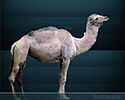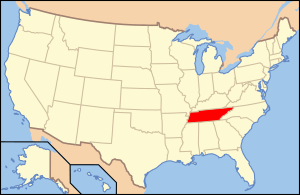Paleontology in Tennessee facts for kids
Paleontology in Tennessee is all about finding and studying ancient life forms, like fossils, right here in the state of Tennessee. Long, long ago, during the early Paleozoic era, Tennessee was covered by a warm, shallow sea. This sea was home to many amazing creatures like brachiopods (shellfish), bryozoans (tiny colonial animals), cephalopods (like ancient squids), corals, and trilobites (ancient sea bugs). Tennessee is actually one of the best places in North America to find Early Devonian fossils!
Later, during the middle and late Carboniferous period, Tennessee became a huge, wet swamp. This swamp was filled with many different kinds of plants, including ferns and giant scale trees. There's a big gap in Tennessee's rock record from the Permian through the Jurassic periods, meaning we don't have many fossils from that time.
But during the Cretaceous period, the western part of Tennessee was again covered by sea. This sea was special because it had more fossil gastropods (snails) than almost anywhere else in the world! Big sea reptiles called mosasaurs and sea turtles also swam in these waters. On land, dinosaurs roamed the eastern part of the state.
Western Tennessee was still under the sea during the early Cenozoic era. Other parts of the state were swampy. The climate then got colder, leading to the Ice Age. During this time, Tennessee was home to large animals like Camelops (an ancient camel), horses, mammoths, mastodons, and huge giant ground sloths. The native Yuchi people even had myths about giant lizard monsters, which might have been inspired by fossils they found! In 1920, scientists made an important discovery of many Ice Age animal fossils near Nashville. Today, the Cretaceous shellfish Pterotrigonia thoracica is the official Tennessee state fossil.
Contents
Ancient Times in Tennessee
Life in the Paleozoic Era
Long, long ago, during the Precambrian time, Tennessee was in the southern part of the world and completely covered by ocean. As the Paleozoic era began, Tennessee was still under a shallow sea, located at the southern edge of North America.
Ordovician Period: A Sea Full of Life
During the Ordovician period, Tennessee was covered by shallow seas. The rocks formed from these ancient seas are now famous for their amazing fossils. Many different types of sea creatures lived here:
- Algae fossils have been found in Rutherford and Smith Counties.
- Brachiopods, which are shellfish, were common in Rutherford and Smith Counties.
- Tiny colonial animals called bryozoans are also found in Rutherford and Smith Counties.
- Cephalopods, like ancient squids, lived in Rutherford County.
- Corals were found in Rutherford and Smith Counties.
- Small crustaceans, like ancient shrimp, were preserved in Smith County.
- Cystoids, a type of ancient sea lily, were found in Smith County.
- Gastropods (snails) lived in Rutherford County.
- Hydrozoans, related to jellyfish, were found in Smith County.
- Tiny, shelled creatures called ostracods were preserved in Rutherford County.
- Pelecypods (another type of shellfish) lived in Smith County.
- Sponges were found in Rutherford and Smith Counties.
- Starfish fossils were preserved in Rutherford County.
- Stromatoporoids, which were sponge-like creatures, also lived here.
- Trilobites, ancient sea bugs, were found in Rutherford County.
Silurian and Devonian Periods: Seas Continue to Thrive
Tennessee remained covered by seawater during the Silurian period. The animals living then included brachiopods, bryozoans, crinoids (sea lilies), and gastropods. The sea stayed in place through the Devonian period. During the Early Devonian, brachiopods and gastropods were still common.
Places like Decatur and Benton Counties have fossils of many creatures. Brachiopods are the most common, along with many bryozoans, crinoids, and two types of corals. Tennessee is known as one of the best places in North America to find Early Devonian fossils. One study found at least 99 different types of sea animals from this time in the state's Birdsong shale rock.
Carboniferous Period: From Sea to Swamp
The sea was still present in Tennessee during the early part of the Carboniferous period. The rocks from the Mississippian time are very rich in fossils. During this time, Tennessee was home to large fish, many tiny conodonts, and various plants.
Later in the Mississippian and during the Pennsylvanian periods, Tennessee became a huge swampy area. Large rivers flowed west, forming massive deltas covered in thick swamps. These swamps were full of plants like horsetails and giant scale trees. All this rich plant life left behind many fossils in the rocks of the Cumberland Plateau. The coal we find in Tennessee today also formed from these ancient plants. After this, for the rest of the Paleozoic era, rocks were being worn away instead of being laid down, so there are no fossils from that time.
Life in the Mesozoic Era
The early part of the Mesozoic era, which includes the time of the dinosaurs, is also missing from Tennessee's rock record. New layers of rock didn't start forming again until the Cretaceous period.
Cretaceous Period: Dinosaurs and Sea Snails
During the Cretaceous period, western Tennessee was once again covered by sea. About 75 million years ago, the area around what is now Coon Creek was just off the coast of a Late Cretaceous sea. This spot is amazing because hundreds of different kinds of gastropod (snail) species were preserved here. It has more diverse gastropods than almost any other fossil site in the world!
Other sea creatures found here include:
- A type of brachiopod.
- Thirty different kinds of bryozoans.
- Two types of corals.
- Five kinds of crustaceans.
- 120 different kinds of pelecypods (shellfish).
- Four kinds of scaphopods (tusk shells).
- Two kinds of starfish.
- Two kinds of worms.
Vertebrate animals (animals with backbones) included mosasaurs (large marine reptiles), sea turtles, and seven major groups of fish. Tiny foraminiferan fossils are also very common in Cretaceous rocks in Hardin, McNairy, Henderson, and Chester Counties.
While the west was underwater, the eastern part of Tennessee was dry land and home to dinosaurs! Among them were duck-billed hadrosaurs.
Life in the Cenozoic Era

Western Tennessee was sometimes covered by warm, tropical seas during the Tertiary period of the Cenozoic era. These seas were home to many molluscs (like clams and snails). A few tiny foraminiferans from Eocene Tennessee have also been found.
From Forests to Ice Age
On land, rivers flowed through the state. Tennessee was covered by different types of forests and swamps. Early Tertiary plant fossils from western Tennessee show that the area had a tropical climate, similar to what you find in modern Central or South America. Animals living in Tennessee during this time included alligators, Red pandas, elephants, and tapirs.
The climate then got much colder during the Quaternary period, leading to the Ice Age. Even though huge glaciers covered much of North America, they didn't reach far enough south to cover Tennessee. However, the cold climate brought new animals to the state. These included:
- The camel Camelops.
- Deer.
- Two types of horses: Equus complicatus and Equus leidyi.
- Mastodons.
- The huge giant ground sloth Mylodon harlani.
- Various turtles.
All these animals left their remains in the floodplain sediments east of the Cumberland River.
Discovering Fossils: Scientific Research
One of the first important fossil discoveries in Tennessee was a possible piece of amber found in the 1800s near Savannah. Amber is fossilized tree resin, sometimes with insects trapped inside!
Another big discovery happened in 1920. Fossils dug up from Ice Age deposits near Nashville were sent to the Carnegie Museum. A pit dug into the floodplain sediments east of the Cumberland River revealed a deer antler, a tooth from the horse Equus leidyi, and leg bones from another horse species called Equus complicatus. Higher up in the same layers, diggers found turtle bones, a tooth from a young mastodon, Camelops fossils, and a tooth from the giant ground sloth Mylodon harlani. These finds helped scientists learn more about the ancient animals that lived in Tennessee.
Places to Learn More: Natural History Museums
If you want to see real fossils and learn more about Tennessee's ancient past, you can visit these museums:
- Frank H. McClung Museum, in Knoxville
- Gray Fossil Museum, in Gray
- Middle Tennessee Museum of Natural History, in Murfreesboro
- Pink Palace Museum and Planetarium, in Memphis


